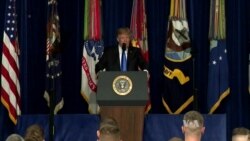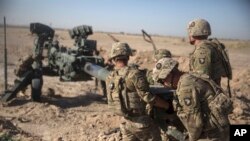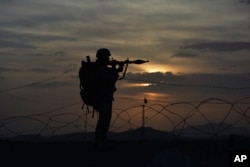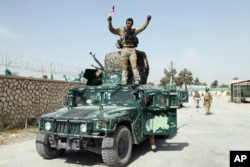President Donald Trump's adjustment of U.S. strategy in Afghanistan will alter the dynamics in the United States' longest war, Secretary of State Rex Tillerson said Tuesday, because American military commanders will be newly empowered to make decisions based on conditions on the ground, rather than on local politics or other factors.
"The fighting will still be borne by the Afghan forces, by their military and their security forces," Tillerson told reporters in a rare appearance at the State Department briefing room. "We believe that we can turn the tide of what has been a losing battle over the last year and a half or so, and at least stabilize the situation and hopefully start seeing some battlefield victories."
Tillerson: New Strategy Will 'Turn the Tide' From Losing Battle in Afghanistan
In his discussion of Trump's address to the nation on Monday night, Tillerson praised "the Afghan forces who have fought very bravely, but they've been fighting, I think, with less than the full capabilities that we can give them." He said Trump's Afghanistan strategy differs from those of his two predecessors at the White House, Barack Obama and George W. Bush, in that it does not set artificial timelines or announce troop levels in advance.
U.S. actions in Afghanistan will be based on conditions on the ground, Tillerson said: "This entire effort is intended to put pressure on the Taliban, to have the Taliban understand that you will not win a battlefield victory."
Objective is negotiation
Continuing his remarks, phrased as if they were directed to the Taliban, Tillerson said: "We may not win one, but neither will you. So at some point, we have to come to the negotiating table and find a way to bring this to an end."
Secretary of Defense James Mattis, who was in Baghdad Tuesday, said he had not yet decided how many troops to send to the South Asian country, and would not do so until he had consulted General Joseph Dunford, chairman of the Joint Chiefs of Staff.
In his address Monday night from a military base outside Washington, Trump said he would not be specific about how many more troops might be sent into Afghanistan, or discuss plans for further military activities. He declared this was part of a "condition-based approach" to defeating terrorism there.
However, U.S. sources who refused to be identified said Trump has already approved sending up to 4,000 more American service members to Afghanistan, to enlarge the current force of about 8,400 U.S. troops.
Most American soldiers in the war zone are advising Afghan forces, but some are tasked with carrying out counterterrorism operations against groups such as the Taliban or the Islamic State's Afghan affiliate. Overall U.S. troop strength is down significantly from seven years ago, when nearly 100,000 Americans were deployed in Afghanistan at the height of the Obama administration's "surge" program to overwhelm the Taliban.
After years of deriding the U.S. war in Afghanistan as a "complete waste," Trump on Monday explained why he now believes it is in the United States' interest to remain committed to the country. His goal, he said, is to stop the re-emergence of safe havens in which terrorists can threaten America and make sure they do not get their hands on nuclear weapons.
Regional approach
Tillerson echoed Trump's statement that the U.S. is seeking a regional approach to solving Afghanistan's difficult problems, including India as well as Pakistan.
Pakistan was sure to be dismayed by president's inclusion of India, its traditional rival, in efforts to resolve the crisis in Afghanistan, as well as by this caution from the top U.S. diplomat: "Pakistan must adopt a different approach, and we are ready to work with them to help them protect themselves against ... terrorist organizations" operating in Pakistani territory.
However, Tillerson added, Pakistan must "begin to end" its efforts in the Afghan border region "that are disrupting our efforts at peace."
"What everybody should be banking on," former U.S. diplomat David Sedney said, "is [that] the United States will be with Afghanistan and make sure that it never again becomes a haven for terrorists. That means that the Taliban are not going to come back. And Pakistan must stop supporting the Taliban."
Sedney told VOA's Urdu program View 360: "Pakistan must take an affirmative test to stop the Taliban leadership from meeting in Pakistan, to stop arms and ammunition and explosives from coming from Pakistan into Afghanistan. Pakistan now knows that it cannot wait out the United States."
William Goodfellow, who is with the Center for International Policy, a public policy research group in Washington, told the same VOA program that he did not see Trump's announcement as a big change in U.S. strategy.
"I think the reason they're adding more troops is because they're worried that the Taliban have the initiative and the American generals were saying, 'Well, we have a stalemate,' " Goodfellow said. "Well, we don't have a stalemate. The American side is losing. And I think adding more troops will try to bring back a situation where you actually have a stalemate and set the stage for a negotiated settlement."
Evaluations differ
Analysts' overall reviews of the president's address were mixed.
"The president failed to define the goals or objectives that would direct the actions of the whole of government approach. The only thing he demonstrated was that his original belief, that you can rip troops out of a combat zone without considering the fallout of that action, was in fact wrong," said Moira Whelan, a partner of BlueDot Strategies and a former senior State Department official.
"Trump repealed his original Afghanistan position, but he failed to replace it with something that will make America safer," she added.
The conflict in Afghanistan began within weeks of the al-Qaida terror network's attacks on New York and Washington on September 11, 2001. At the time, a Taliban administration was in control in Kabul, and al-Qaida had freedom of operations in much of the country. Regular government was restored in Afghanistan and the Taliban was expelled from the capital, but the country's factionalized unity government and systemic corruption have resulted in the war dragging on for almost 16 years.
In an expression of his frustration, Trump said leaders in Kabul must realize that the U.S. commitment to Afghanistan is not unlimited. The American people, he warned, expect "to see real reforms and real results."
VOA's Steve Herman, Victor Beattie, Bill Gallo, Ayaz Gul and Chris Hannas contributed to this report.















